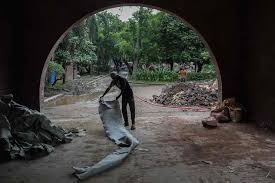One year after the dramatic fall of Sheikh Hasina’s government, the former residence of Bangladesh’s long-serving prime minister has been transformed into a museum chronicling the student-led uprising that ended her rule. The Ganabhaban palace in Dhaka, once a tightly guarded seat of power, now stands as a symbol of resistance and a cautionary tale against authoritarianism.
On August 5, 2024, jubilant crowds stormed the opulent compound after Hasina fled by helicopter to India amid intensifying protests. Graffiti condemning her regime reading “Freedom,” “We want justice,” and “Killer Hasina”—remains untouched, preserved as stark reminders of public outrage.
Hasina, 77, is currently on trial in absentia for crimes against humanity, charges she denies. Her administration has been accused of widespread human rights abuses, including the extrajudicial killings of political opponents. According to the United Nations, up to 1,400 people were killed during her final months in power.
The caretaker government, led by Nobel laureate Muhammad Yunus, is overseeing the museum’s construction. Yunus described the project as a way to “preserve memories of her misrule and the people’s anger.” The exhibits will feature photos, films, and artefacts commemorating those who died, alongside reconstructions of prison cells used to detain dissidents.
“This place will symbolise our trauma, our suffering, and our resistance,” said Mosfiqur Rahman Johan, a rights activist who joined the storming of the palace.
The museum also reflects Bangladesh’s effort to reckon with its past. Statues of Hasina and her father, Sheikh Mujibur Rahman the nation’s founding leader have been destroyed by protesters. His former home, which had been turned into a memorial, was demolished by crowds seeking to erase symbols of what they describe as a family dictatorship.
Curator Tanzim Wahab hopes the museum will inspire younger generations to engage in democratic discourse. “It’s about looking back, understanding what went wrong, and imagining a better future.”
As Bangladesh prepares for elections in early 2026, the Ganabhaban museum stands as both a monument to past struggles and a beacon for democratic renewal.

